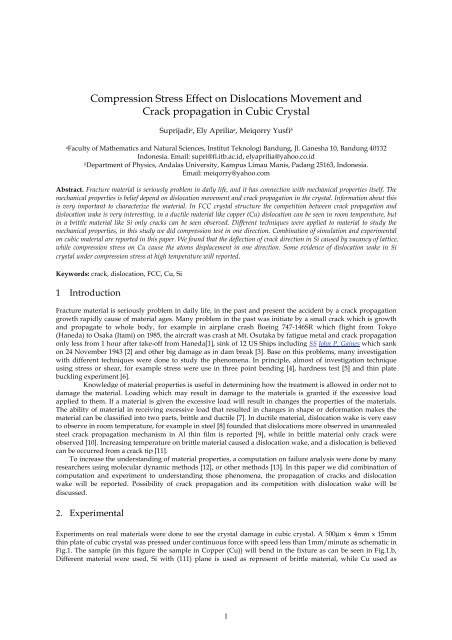RECENT DEVELOPMENT IN COMPUTATIONAL SCIENCE
RECENT DEVELOPMENT IN COMPUTATIONAL SCIENCE
RECENT DEVELOPMENT IN COMPUTATIONAL SCIENCE
You also want an ePaper? Increase the reach of your titles
YUMPU automatically turns print PDFs into web optimized ePapers that Google loves.
Compression Stress Effect on Dislocations Movement and<br />
Crack propagation in Cubic Crystal<br />
Suprijadi a, Ely Aprilia a, Meiqorry Yusfi b<br />
aFaculty of Mathematics and Natural Sciences, Institut Teknologi Bandung, Jl. Ganesha 10, Bandung 40132<br />
Indonesia. Email: supri@fi.itb.ac.id, elyaprilia@yahoo.co.id<br />
bDepartment of Physics, Andalas University, Kampus Limau Manis, Padang 25163, Indonesia.<br />
Email: meiqorry@yahoo.com<br />
Abstract. Fracture material is seriously problem in daily life, and it has connection with mechanical properties itself. The<br />
mechanical properties is belief depend on dislocation movement and crack propagation in the crystal. Information about this<br />
is very important to characterize the material. In FCC crystal structure the competition between crack propagation and<br />
dislocation wake is very interesting, in a ductile material like copper (Cu) dislocation can be seen in room temperature, but<br />
in a brittle material like Si only cracks can be seen observed. Different techniques were applied to material to study the<br />
mechanical properties, in this study we did compression test in one direction. Combination of simulation and experimental<br />
on cubic material are reported in this paper. We found that the deflection of crack direction in Si caused by vacancy of lattice,<br />
while compression stress on Cu cause the atoms displacement in one direction. Some evidence of dislocation wake in Si<br />
crystal under compression stress at high temperature will reported.<br />
Keywords: crack, dislocation, FCC, Cu, Si<br />
1 Introduction<br />
Fracture material is seriously problem in daily life, in the past and present the accident by a crack propagation<br />
growth rapidly cause of material ages. Many problem in the past was initiate by a small crack which is growth<br />
and propagate to whole body, for example in airplane crash Boeing 747-146SR which flight from Tokyo<br />
(Haneda) to Osaka (Itami) on 1985, the aircraft was crash at Mt. Osutaka by fatigue metal and crack propagation<br />
only less from 1 hour after take-off from Haneda[1], sink of 12 US Ships including SS John P. Gaines which sank<br />
on 24 November 1943 [2] and other big damage as in dam break [3]. Base on this problems, many investigation<br />
with different techniques were done to study the phenomena. In principle, almost of investigation technique<br />
using stress or shear, for example stress were use in three point bending [4], hardness test [5] and thin plate<br />
buckling experiment [6].<br />
Knowledge of material properties is useful in determining how the treatment is allowed in order not to<br />
damage the material. Loading which may result in damage to the materials is granted if the excessive load<br />
applied to them. If a material is given the excessive load will result in changes the properties of the materials.<br />
The ability of material in receiving excessive load that resulted in changes in shape or deformation makes the<br />
material can be classified into two parts, brittle and ductile [7]. In ductile material, dislocation wake is very easy<br />
to observe in room temperature, for example in steel [8] founded that dislocations more observed in unannealed<br />
steel crack propagation mechanism in Al thin film is reported [9], while in brittle material only crack were<br />
observed [10]. Increasing temperature on brittle material caused a dislocation wake, and a dislocation is believed<br />
can be occurred from a crack tip [11].<br />
To increase the understanding of material properties, a computation on failure analysis were done by many<br />
researchers using molecular dynamic methods [12], or other methods [13]. In this paper we did combination of<br />
computation and experiment to understanding those phenomena, the propagation of cracks and dislocation<br />
wake will be reported. Possibility of crack propagation and its competition with dislocation wake will be<br />
discussed.<br />
2. Experimental<br />
Experiments on real materials were done to see the crystal damage in cubic crystal. A 500µm x 4mm x 15mm<br />
thin plate of cubic crystal was pressed under continuous force with speed less than 1mm/minute as schematic in<br />
Fig.1. The sample (in this figure the sample in Copper (Cu)) will bend in the fixture as can be seen in Fig.1.b,<br />
Different material were used, Si with (111) plane is used as represent of brittle material, while Cu used as<br />
1


